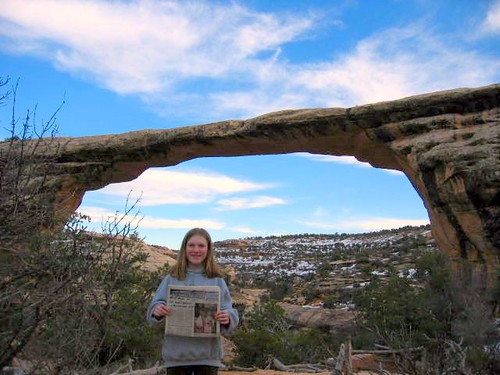If you’ve been to Utah, you probably don’t think there’s much wildlife, especially if you’ve been in February. During my school vacation week in February, we visited Natural Bridges National Monument in southwestern Utah. The only wildlife I saw in Utah were the mule deer that crossed the deserted road in front of our car at dusk as we were leaving.

Reading the Local Newspaper in Front of an Arch
To me, the most interesting wildlife in and around the Monument is the animal most people hope they don’t see: the midget faded rattlesnake. You’re not likely to see this reptile in the winter anyway because it hibernates, so February was a good time to visit southern Utah for this reason. The people who work at the Monument reported seeing so many of these poisonous rattlesnakes around their homes that scientists investigated. Supposedly twenty-five were captured and relocated in one year. Captured snakes had small radio transmitters inserted under their skin so they could be tracked. It turns out that the snakes’ trails and some of their dens were near the residences of the Monument employees. It’s funny that the snakes and the people like to live in the same place in this remote region, when it seems like there is so much space to spread out.
I liked living in Maine, before moving to New Hampshire, because there weren’t any rattlesnakes or other kinds of poisonous snakes. I know there is a very rare rattlesnake in New Hampshire called the Timber Rattlesnake. The New Hampshire Fish and Game Department is trying to save this snake. They only know of one place where this snake can still be found in the state. Of course, they don’t want to tell everyone the location because they don’t want collectors to take the last ones. On the New Hampshire Audubon website, it says these rattle snakes have between 5 to 14 babies at a time.
This February was a nice time to visit Natural Bridges National Monument for another reason. The area had gotten lots of snow recently, and it was melting. There were streams flowing and waterfalls; the canyons were full of water noise.
It used to be a five day horseback ride from the nearest town to visit the three natural bridges in the Monument. Today electricity in the Monument comes from solar collectors near the Visitors Center.
The second and third largest natural bridges in the world are located in the Monument. The first non-native to find the bridges named them: President, Senator, and Congressman - but the names were later changed to Hopi words - Sipapu, Kachina, and Owachomo. The Hopis who use to live in the canyons left drawings painted or scraped into the rock. Their Native American reservation is south of the Monument.
From one canyon wall we could look down and see a big Native American ruin in a shallow cave. The trail to the ruin started on the edge of the cliff and had ladders and rails, but was too muddy, snowy, and slippery to follow. The best part of my trip was hiking down to the last bridge for a view “under the horse’s belly.” This is how the earliest visitors, horseback riders, described looking up from under the bridges. It is worth finding this out of the way place. I want to go back!
Sydney Kahl is a member of the Youth Travel Blogging Mentorship Program.
Photo courtesy and copyright Sydney Kahl
